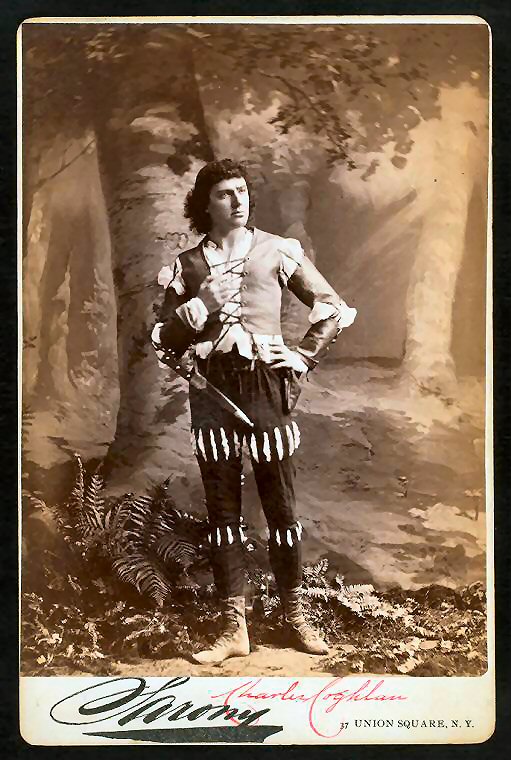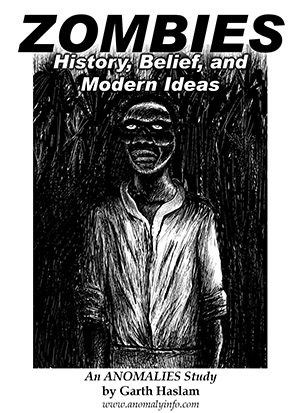1900, September 8: Coghlan’s Coffin
Born in 1841, Charles Francis Coghlan was raised and educated in both Paris, France, and London, England... and despite his parents' hope that he would become a lawyer, he had an interest and natural talent for both writing and acting. His first appearance upon stage in a minor role was at the age of 19 in 1860; by 1862, he was playing the lead roles.

Over the next 37 years, Charles Coghlan became well renowned for his acting talent on tours throughout Europe and North America. He eventually bought a farm on Prince Edward Island in Canada, and retired -- twice. Each time the call of the stage coaxed him back out for just one more set of performances. It was during the second such tour in 1899, when Coghlan was portraying the part of Clarence in "The Royal Box" at various theaters in the US, that his career finally came to an end. The actor became ill sometime just after an October performance in Houston, Texas; and as the group moved on to the next venue at Galveston, Coghlan's health took a distinct turn for the worse... he died on November 27.
He was given a beautiful metal coffin, and temporarily interred at a local cemetery to await his ultimate fate, which was being disputed. Some of his family wanted to send him back to Prince Edward Island to be buried near his farm; some of his family wanted him to be cremated and buried in France or London. Because Coghlan was essentially famous, the argument over who had rights to his remains carried on for nearly a year, until Mother Nature decided the matter for everyone.
On September 8, 1900, the city of Galveston, Texas, was nearly destroyed by a hurricane. The hurricane was responsible for between 6,000 to 12,000 deaths; and it also greatly destroyed the graveyard, washing many caskets and coffins out to sea in the Gulf of Mexico... including the coffin of Charles Coghlan. A desperate search for Coghlan's coffin began, as friends and family stretched their hopes and resources to find clues to its whereabouts.
The most spectacular answer to the location of the missing coffin was notably publicized in 1927, by cartoonist Robert Ripley in his famous Ripley's Believe It Or Not! comic strip. Ripley asserted that the wandering coffin of Charles Coghlan had eventually turned up again, and in a very surprising place: years after the hurricane, the metal coffin of Charles Coghlan -- apparently airtight enough to float -- had washed ashore on Prince Edward Island, not far from his home! The coffin had traveled on ocean currents across the Gulf of Mexico, around the tip of Florida, then northwards up the coast to reach the actor's home island... Believe It or Not!
If only the real story was that simple. Oh, well.
Not.
Robert Ripley and his Believe It or Not! comic strip had become famous in the early 20th Century for two reasons, the first being the amazing nature of the stories his comic strip told. The second reason was because he also claimed that each and every story he told in the strip was true... and Ripley had a standing policy of sending proof of that truth to anyone who cared to challenge one of his amazing stories, so almost nobody doubted his claims.
But "true" and "truth" are relative words; often, Ripley's form of proof was simply to show that someone else had asserted a story as true. If that person was mistaken or lying, it was hardly Ripley's fault, right?
Now don't get me wrong here: I am, and always will be, a big fan of Robert Ripley and his original comic strips and books. However, in the case of Charles Coghlan's wandering coffin, I must note that Ripley took someone else's word for the story he reported. His claimed sources to prove that Coghlan's coffin floated all the way home were two books by people who had also been involved in the world of the theater at the time that Coghlan died, and what they said needs to be examined.
Sir Johnston Forbes-Robertson [1853-1937] was an English actor and theater manager who published his memoirs -- A Player Under Three Reigns -- in 1925. Forbes-Robertson had been a personal friend of Coghlan, and in his book he speaks briefly of the fate of Coghlan's coffin:
"Shortly after his burial there [in Galveston] a great storm came up from the Gulf which swept his [Coghlan's] coffin with others into the sea. The Gulf Stream bore him round Florida, up the coast about fifteen hundred miles to Prince Edward Island, and he came ashore not far from his home."
Ripley's other reported source is another memoir, The Days I Knew, by actress Lillie Langtry [1853-1929] and also published in 1925... though there is no good reason he included it. Here's what she tells us about Charles Coghlan:
"He died and was buried at Galveston, Texas, but his remains were not allowed to rest in peace, for the tidal wave that later demolished that town invaded the cemetery and swept many of the coffins (including that of Charles Coghlan) out to sea, which singular happening to his remains was predicted for him by a crystal-gazer while he was still a young man!"
So Langtry doesn't mention the fate of the coffin in any way, but does add a note of the supernatural to the tale... and may have been included by Ripley as one of his sources simply so he could at least pretend he had more than just one source for the story.
Forbes-Robertson's story of the fate of Coghlan's coffin, while romantic, didn't happen.
Charles Coghlan is not interred anywhere on Prince Edward Island, and for one simple reason: no one has found his coffin yet.
A Strange Fate
It's perfectly true that Charles Coghlan's casket was sucked out to sea by that hurricane in 1900... but from there, the story gets very odd indeed. In trying to confirm or disprove Ripley's account of the coffin's fate, I discovered a very remarkable series of reports regarding the actor's remains... here's the brief list.
- On September 27, 1900, it was reported that Coghlan's casket was found sixteen miles north of Galveston, near the town of La Marque; the undertaker who first placed the casket in the vault in Galveston was on his way to La Marque to identify the remains.
- On January 22, 1904, it was reported that a metallic casket believed to belong to Coghlan had been found on the beach near Galveston.
- On January 19, 1907, it was reported that Coghlan's metal coffin had been found almost buried in a marsh, hidden by weeds about nine miles from Galveston.
- In 1909, a memoir written by Squire and Marie Effie Bancroft, theater actors and managers, stated that Coghlan's coffin had been found floating on the ocean "some time afterwards" of the hurricane, and been reburied... keeping in mind it hadn't been buried before.
- In April 1918, Lillie Langtry first made the claim that a "crystal-gazer" had foreseen the fate of Coghlan's remains when he was a young man, a claim she repeated in her memoirs later.
- In a June, 1922, article about Rose Coghlan -- Charles Coghlan's sister who was also an actress -- it is stated that the iron coffin of her brother was never recovered.
And then, of course, in 1925 Forbes-Robertson told the story of the coffin traveling back to Prince Edward Island, followed in 1927 by Robert Ripley making the story famous.
When the hurricane struck Galveston, a lot of coffins were washed out to sea; it seems likely that the various discoveries of "Coghlan's coffin" were, if not false, just other coffins washed away in the disaster. Once a mistake was noted, no newspaper would waste much time correcting an earlier article. What's more remarkable is that people were still actively hoping to find the actor's coffin at least nine years after it had been lost; and there were still enough people concerned about it twenty-five years later that a going rumor existed about the coffin floating home.
No grave is marked for Charles Coghlan in either Galveston or on Prince Edward Island. In a time that predated television, movies, and even radio as entertainment sources, traveling theater troupes were the way stories were told and shared; and Charles Coghlan was as famous an actor then, as any Hollywood or internet personality now. When Coghlan's body vanished, those that knew and loved him -- both personally and as a favorite actor -- were left with no closure. Truthfully, the continued need of the public for answers regarding the fate of the actor's remains is probably more a testament to Coghlan's skills than any mere tomb or monument ever would be.
Anomalies -- the Strange & Unexplained, as well as my other website -- Monsters Here & There -- are supported by patrons, people like you! All new Anomalies articles are now posted for my patrons only, along with exclusive content made just for them. You can become a patron for just $1 a month!
|








